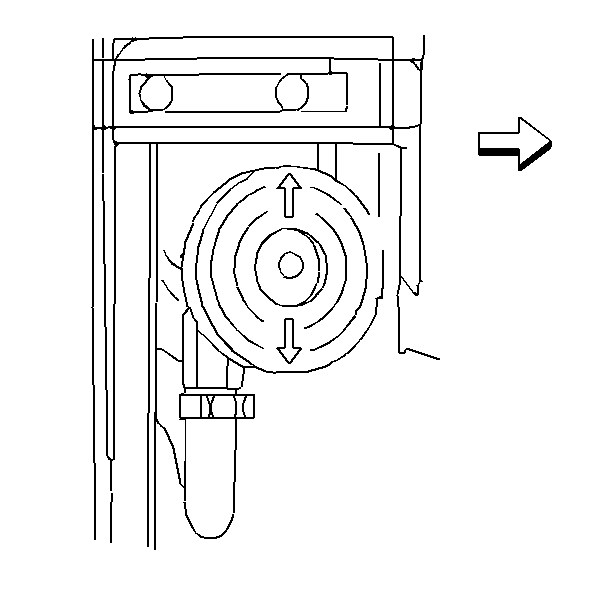Draining Procedure
Caution: As long as there is pressure in the cooling system, the temperature
can be considerably higher than the boiling temperature of the solution in
the radiator without causing the solution to boil. Removal of the pressure
cap while the engine is hot and pressure is high will cause the solution
to boil instantaneously -- possibly with explosive force -- spewing
the solution over the engine, fenders and the person removing the cap.
Notice: When adding coolant, use DEX-COOL® coolant. If silicated coolant
is added to the system, premature engine, heater core or radiator corrosion
may result. In addition, the engine coolant will require change sooner-at
50 000 km (30,000 mi) or 24 months.
Notice: The 4.0L engine uses DEX-COOL™ and GM coolant supplement (sealant)
P/N 3634621 specifically designed for use in aluminum engines. Failure to
use the engine coolant supplement (sealant) and the approved coolant antifreeze
could result in major engine damage. When refilling the cooling system, add
three pellets of the engine coolant supplement sealant GM P/N 3634621 to lower
the radiator hose.

- Open the radiator drain cock at the bottom of the radiator.
- If the coolant is dirty, or if there are deposits in the radiator,
flush the cooling system before refilling. Refer to Flushing
.
- Remove the radiator/surge tank pressure cap. Refer to
Radiator Assembly
.
| 3.1. | Clean, test, and replace the cap if needed. Refer to Radiator Diagnosis
. |
| 3.2. | Clean the radiator/cooling system filler neck. Inspect the filler
neck. |
- Disconnect the hoses from the recovery reservoir/surge tank. Remove
the reservoir/surge tank.
- Clean the coolant recovery reservoir/surge tank.
| • | Clean the inside of the reservoir/surge tank using soap and water. |
| • | Thoroughly flush the reservoir/surge tank with clean water. Then
drain the reservoir/surge tank. |
- Install the reservoir/surge tank. Connect the hose(s).
Engine Coolant Recycling
Tools Required
GM approved Recycling System such as Pro Clean (Available in the GM
Dealer Equipment Program)
Whenever the cooling system needs maintenance or repairs, remove and
replace the coolant with qualified new or recycled coolant.
If you only drain the radiator, up to 50 percent of the used, contaminated
coolant can remain in the cooling system.
Use any of the following methods in order to remove the coolant:
| • | Use a waterless coolant evacuation system, available in the GM
Dealer Equipment program, or equivalent, that removes the used coolant and
replaces the coolant with new or recycled coolant. |
| • | Use a GM approved coolant recycling system, available in the GM
Dealer Equipment program, or equivalent, that recycles the coolant on the
vehicle. This eliminates the need for coolant evacuation. |
| | Important: Do not recycle coolant on vehicles manufactured with GM Goodwrench Dex-Cool.
|
| • | Recover the used coolant. Store the coolant in a used coolant holding
tank. Submit the used coolant for recycling on a regular basis. |
Filling Procedure

- Close the radiator drain cock.
Notice: Pure coolant can be added to raise the boiling point of the coolant,
but too much will affect the freezing point. Do not use a solution stronger
than 70 percent, as the freeze level rises rapidly after this point.
Pure coolant will freeze at -22°C (-8°F).
- Refill the cooling system. In order to ensure sufficient engine cooling,
freezing and corrosion protection, maintain the coolant protection level at -37°C
(-34°F) or lower.
- Set the heater/A/C control in any A/C mode except MAX. Set the
temperature to the highest setting.
- Allow the engine to continue idling until the radiator outlet
hose becomes hot.

- Cycle the engine speed up to about 3,000 RPM and back to idle
5 times. On the L36 and L67 engines, slowly open the bleed valve on the rear
of the thermostat housing for about 15 seconds in order to release any trapped
air in the cooling system.

- After the air has been released, fill the radiator. Install the radiator/surge
tank pressure cap. The arrows (1) on the pressure cap must line up with the
overflow tube (2). (L36 and L67)
- Allow the engine to cool to the outside temperature. Then, check
the coolant level in the reservoir/surge tank. If the coolant level is not
at the appropriate mark, add coolant until the coolant reaches the proper
level.




